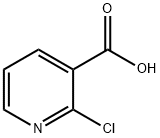2942-59-8

SAFETY INFORMATION
| Signal word | Warning |
|---|---|
| Pictogram(s) |
 Exclamation Mark Irritant GHS07 |
| GHS Hazard Statements |
H315:Skin corrosion/irritation H319:Serious eye damage/eye irritation H335:Specific target organ toxicity, single exposure;Respiratory tract irritation |
| Precautionary Statement Codes |
P261:Avoid breathing dust/fume/gas/mist/vapours/spray. P264:Wash hands thoroughly after handling. P264:Wash skin thouroughly after handling. P271:Use only outdoors or in a well-ventilated area. P280:Wear protective gloves/protective clothing/eye protection/face protection. P302+P352:IF ON SKIN: wash with plenty of soap and water. P305+P351+P338:IF IN EYES: Rinse cautiously with water for several minutes. Remove contact lenses, if present and easy to do. Continuerinsing. |
PRODUCT INTRODUCTION
Description
2-Chloronicotinic acid as a pyridine derivative is receiving much attention because of its effective application as an essential precursor in synthesising pesticides and pharmaceuticals. It is extensively used to synthesise the new high-efficiency herbicides nicosulfuron and diflufenican, which have low toxicity, high biological activities, broad-spectrum activity, and outstanding environmental compatibility. It is also a key building block for new endogenous fungicides (pyridinimide), antimicrobial agents and anticancer drug intermediates (2-chloropyridine-3-carbonyl-containing heterocyclic compounds), new non-nucleoside reverse transcriptase inhibitors, HIV reverse transcriptase inhibitors (nevirapine), pesticides, and pharmaceutical intermediates. Among these, nicosulfuron is an efficient corn herbicide, and the market demand is increasing yearly.